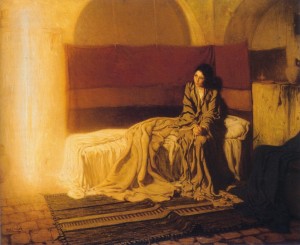Anyone else out there have daughters? My daughter, Sophia, is a month away from being 3-years-old. Here was our conversation yesterday, and I should let you know we have three pregnant ladies in our church right now.
 Sophia: I have a baby in my tummy.
Sophia: I have a baby in my tummy.
Dad: You don’t have a baby in your tummy.
Sophia: Yes I do have a baby in my tummy.
Dad [thinking fast]: Only mommies can have babies in their tummies. When you get bigger, and marry a daddy, then you can have a baby in your tummy.
Sophia: Okay.
Dad: [Whew]
Perhaps someone read 1 Timothy 2:15 to her. But women will be saved through childbearing—if they continue in faith, love and holiness with propriety (NIV). This is one of those verses that causes some people trouble, unless they can read Greek. Young’s Literal Translation translates it best, in my opinion, “she shall be saved through the child-bearing . . .” Let’s not leave out that direct article! Child-bearing is a wonderful thing, but I only know of one child-bearing which I would call “The Child-Bearing,” one child-bearing able to save, the birth of Jesus our Lord. What is conceived in her is from the Holy Spirit. She will give birth to a son, and you are to give him the name Jesus, because he will save his people from their sins (Matthew 1:20-21).
Many people of ancient Ephesus, where Timothy pastored, worshiped Artemis. Christine Thomas (Koester, 1995) states that the Ephesian Artemis, a great goddess figure, existed before Hellenistic influence, back to the founding of the city. However, coins of Ephesus depict Artemis both as the Ephesian Artemis and as the virgin hunter in the Grecian style, so both forms existed simultaneously, perhaps giving Artemis a more powerful mythology in Ephesus. In this context, Paul contrasts Artemis, the virgin and/or mother goddess of Ephesus, with Mary, the virgin mother in Christianity, who would come to be known as the theotokos (god bearer) instead of christotokos, beginning in Ephesus and Constantinople. This elevation of Mary, in essence supplanting the virgin goddess of Ephesus by 431 C.E. would result in the Chalcedonian Formula “born of the virgin Mary, the Mother of God, according to humanity” (Schaff, 2007).

H. O. Tanner 1898
Philadelphia Museum of Art, W. P. Wilstach Collection
In the sixth month of Elizabeth’s pregnancy, God sent the angel Gabriel to Nazareth, a town in Galilee, to a virgin pledged to be married to a man named Joseph, a descendant of David. The virgin’s name was Mary. The angel went to her and said, “Greetings, you who are highly favored! The Lord is with you.”
Mary was greatly troubled at his words and wondered what kind of greeting this might be. But the angel said to her, “Do not be afraid, Mary; you have found favor with God. You will conceive and give birth to a son, and you are to call him Jesus. He will be great and will be called the Son of the Most High. The Lord God will give him the throne of his father David, and he will reign over Jacob’s descendants forever; his kingdom will never end.” (Luke 1:26-33)
References
Thomas, C. (1995). “At Home in the City of Artemis: Religion in Ephesos in the Literary Imagination of the Roman Period.” In Koester, H. (editor), Ephesos Metropolis of Asia: an interdisciplinary approach to its archaeology, religion, and culture. Valley Forge, PN: Trinity Press International.
Schaff, P. (2007). The Creeds of Christendom, Vol. II: The Greek and Latin Creeds. Grand Rapids: Baker Books.






